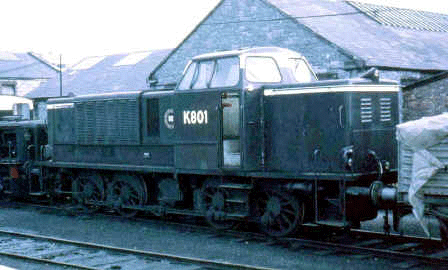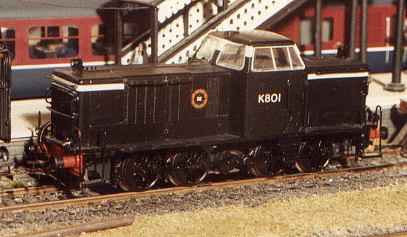Steve Johnson Modelmaker
|
|
MaK K801 Class The Prototype
Picture courtesy of Colour-Rail In the early 1950's, the ailing Great Northern Railway Board (GNRB) was considering dieselisation of the network in an effort to save costs. They already had a fleet of AEC/Park Royal railcars similar to the CIÉ railcars, as well a small fleet of Railbuses on some services. Having had a look around at what was available on the market, the GNRB decided to obtain a locomotive from Maschinenbau aus Kiel (MaK) for evaluation. A number of this type was already in service with Deutsche Bundesbahn as class V65. Delivered late 1954, the locomotive was numbered 800 and carried the GNRB blue livery. Powered by a MaK V16 diesel engine of 800bhp, hydraulic transmission to the eight coupled wheels was by a Voith torque converter with the output shaft between the wheels under the cab. Upon the dissolution of the GNRB in 1958, the locomotive went to CIÉ. It was repainted in CIÉ green livery and was renumbered K801. The locomotive saw little use and spent most of its time lurking around Inchicore were it acquired the black/white livery. Finally, in 1976, it was sold to the Galway Scrap Metal Co. as a stationary generator to power a car crushing plant. Now painted blue with a white cab, it was visible from the mainline for many years at the company's premises near Oranmore Crossing. The locomotive was finally scrapped sometime in the late 1990's. The Model
No kit has been offered for the MaK K Class, however, as mentioned above, the locomotive is based on the DB V65. A trawl through various continental model catalogues and a few telephone calls revealed that a small German manufacturer did offer a model of the V65. My model is made by a company called Hobbytrain and was supplied by Victors. The model is of excellent quality and is equivalent to the best of German ready to run manufacture, but does have a price tag to match. There is of course one problem with the model, it is HO Scale. If you are willing to accept this, then this is a relatively easy way out. As supplied, the locomotive was in DB red livery with the handrails supplied but not fitted. The chassis is a Kato unit with plenty of weight and so gives a particularly smooth performance. Some slight modifications have to be performed to convert the model to its Irish form. The most obvious is the cab door. The model has the doors exiting onto the running plate. These have to carefully filled up and smoothed down. The new doors have to scribed onto the cab sides below the cab windows at the No.2 end. Handrails can now be fitted being made from 0.33mm wire. The bars in the radiator are the wrong orientation, for the Irish version they need to be vertical. The bars are of a slightly rounded profile, so I used some suitable Slater's Microrod cut to the correct length and placed into the grille recess. Turned brass horns were fitted in front of the each cab window in the centre. The Irish version also has some cab steps below the doors. These were made from plascticard and secured into position. My chosen livery was the black/white livery. The white stripes at the bonnet ends are selected lengths of Fox Transfers white lining, the cab lining is painted on. The numbers are Letraset with the CIÉ orange roundal coming from Mabex. Re-gauging this 0-8-0DH locomotive to 21mm gauge P4 might prove difficult as regards compensation. It seems to me that a completely new chassis would have to be constructed. If this were the case, then one might as well build the chassis to the correct 4mm scale and build a new body to match.
|

